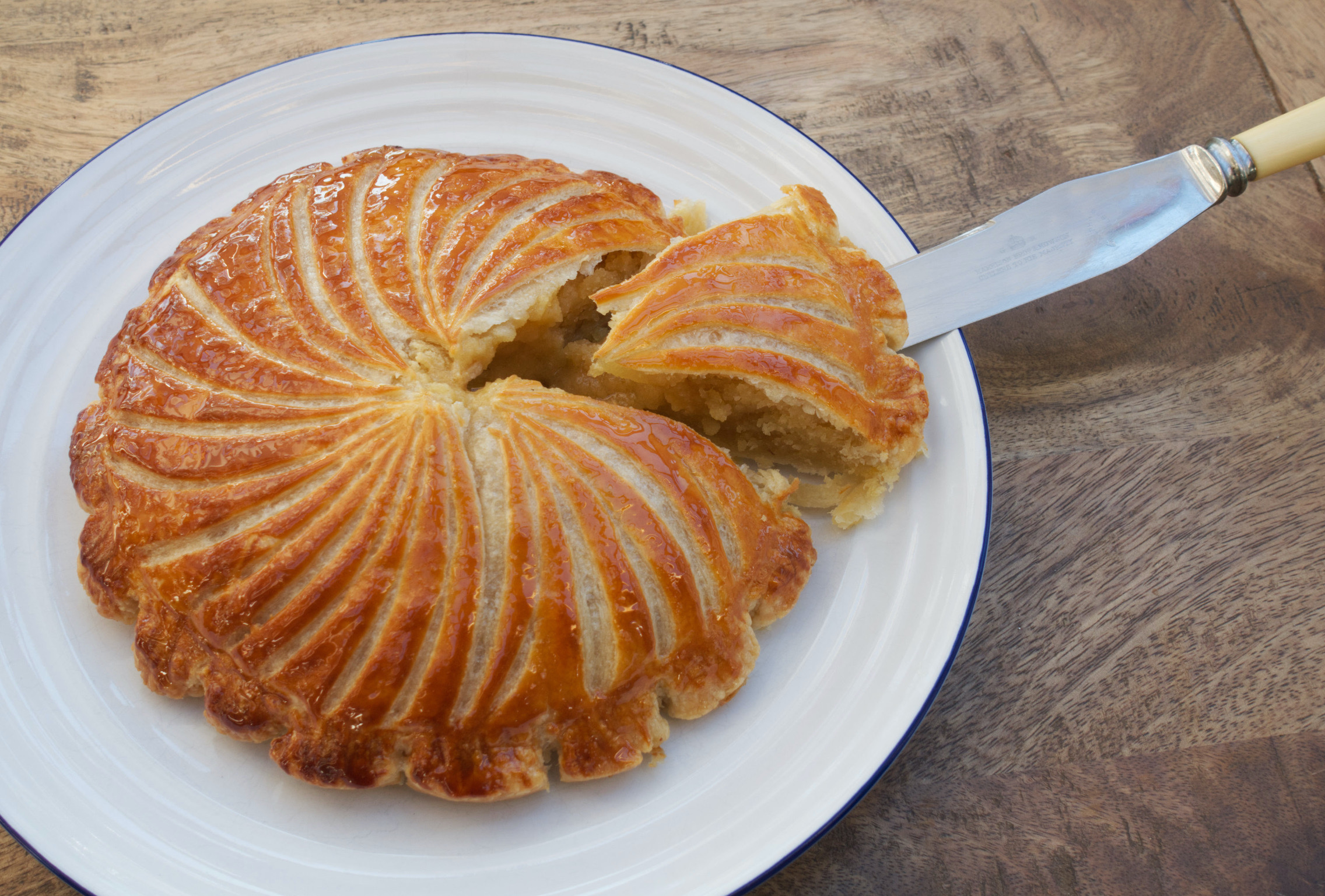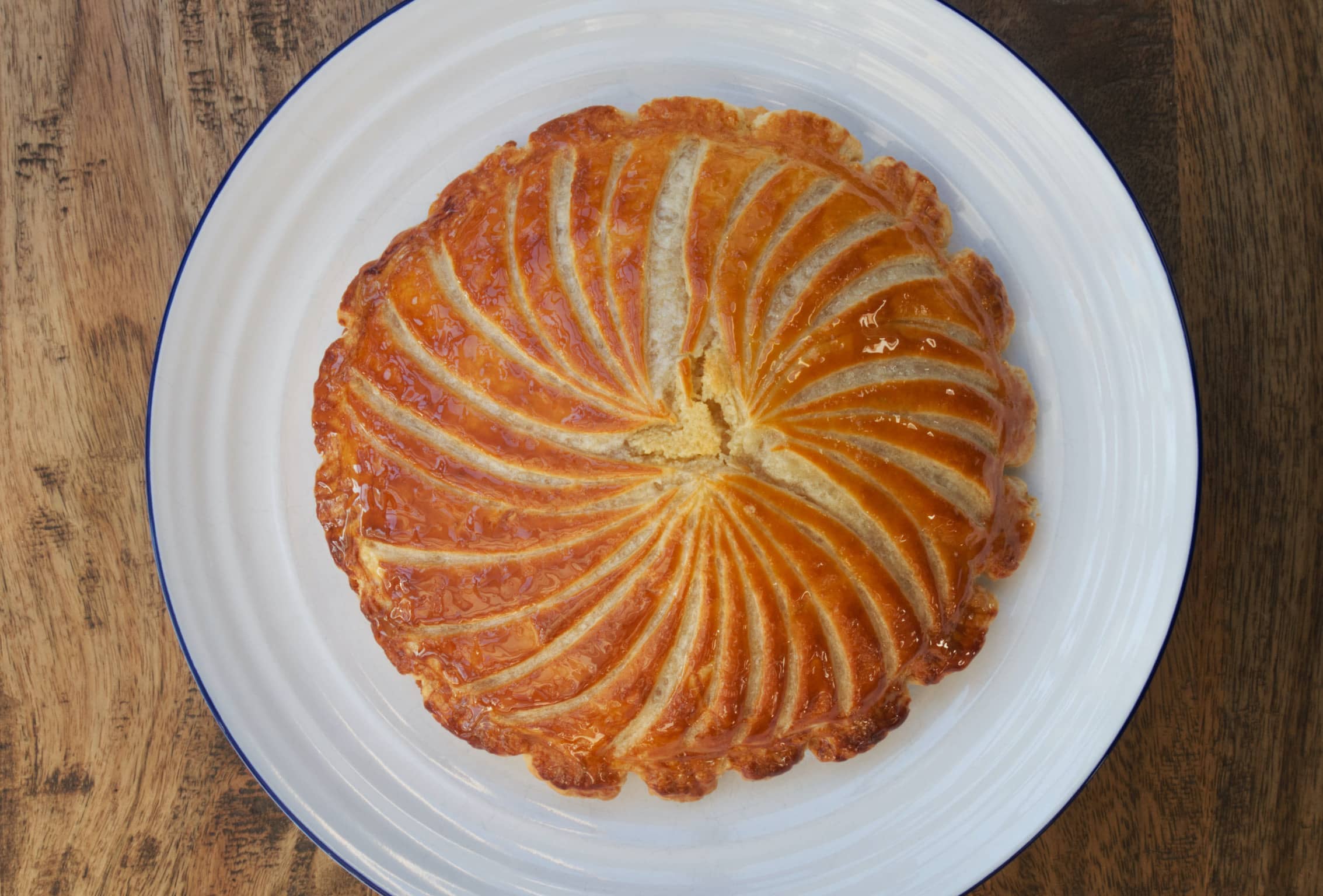There’s always a bit of a post-Christmas sag, isn’t there? The presents have been piled up but not actually put away yet, the tree is dropping needles like there’s no tomorrow, and those final bits and bobs of leftovers in the fridge aren’t looking terribly appealing (a weary parsnip and some withered peas do not a Christmas sandwich make).
So it’s no surprise that the French have made sure there’s something to look forward to before we pack away the festive season for another year: the galette des rois.
Named after the three kings of the nativity story, galettes des rois are traditionally eaten on 6 January, or Epiphany, the day that the magi were supposed to have visited Jesus in his stable. There are variations of Epiphany or twelfth night cake around the world, but the galette des roi is my favourite: a puff pastry tart with a frangipane filling, made of creamed sugar and butter, eggs, ground almonds, and a generous glug of rum. It is usually beautifully decorated with etchings made into the pastry and egg yolk glaze, big bold swoops, or geometric zig zags, that come to life as the pie bakes.
Traditionally, a fève (bean) or small porcelain figure (usually depicting the baby Jesus) would be placed in the pudding before baking, and whoever found the item in their portion would be crowned king or queen for the day. In France, bakers will even provide the actual crown that the victorious diner will receive – although I’m afraid here, you will have to fashion your own. Tradition further dictates that the youngest person partaking should sit under the table and announce recipients’ names as pieces are cut to prevent any skulduggery or manipulation of the hidden item – although surveys suggest that up to 70% of families swing it so that one of the children receive the fève and are duly crowned.
Although these pies are ubiquitous in France, you have to search a little harder for them here. Happily, they are very easy to put together yourself. Frangipane is a cinch to make, and I’m absolutely not going to suggest you make your own puff pastry unless you are long on time and short on bad Christmas films to watch. The recipe requires lots of chilling, which I am actively in favour of during the festive season – each one an excuse for a glass of fizz and a mini mince pie – but it really will make the whole process easier, and the end result more beautiful. Chilling will prevent the pastry stretching out of shape, make sure it rises evenly, and that your scoring is crisp and smart, and doesn’t distort.
You can enjoy a galette de roi warm or cool, although cool it will cut more cleanly, while warm, the frangipane will be softer, slightly gooey. Either way, I like it with pouring cream.

Galette des rois
Makes: Enough for 8
Takes: 20 minutes, plus chilling
Bakes: 45 minutes
500g puff pastry
1 egg yolk
For the frangipane
115g butter
115g caster sugar
2 eggs
110g ground almonds
30g plain flour
2 tablespoons rum
For the glaze
50g sugar
25ml water
- First, roll out the puff pastry to the thickness of a pound coin. Cut the pastry in half, and place each half on a lined baking tray. Cut two discs, one 23cm and one 20cm, but don’t lift them away from the rest of the pastry. Refrigerate for at least 30 minutes.
- Meanwhile, make the frangipane: cream together the butter and sugar until pale and fluffy, then beat each of the eggs into the mixture. Fold through the ground almonds and flour, then stir through the rum.
- Prick the smaller of the two discs of chilled puff pastry all over with a fork. Spoon or pipe the frangipane onto the disc, leaving a 1cm border around the edge. If you’re placing a porcelain figure or a fève in the tart, pop it in the frangipane now.
- Dab the edge of the pastry with egg wash, and lay the second, larger disc of pastry on top. Gently ease it down over the frangipane to eliminate air pockets beneath the pastry while maintaining a nice domed shape, then press firmly at the edges to seal. Refrigerate for an hour.
- Preheat the oven to 200°C, and remove the galette from the fridge. Use the back of your knife to indent the border of the pastry at regular intervals, creating a petal effect. Fork the egg yolk with a small pinch of salt and brush over the pastry. Chill for ten more minutes.
- Starting from the centre, use a small, sharp knife to score sweeping curves to the edge of the pastry. Bake for 15 minutes, then drop the temperature to 160°C and bake for another 30 minutes.
- While the galette is baking, make the sugar glaze: heat together the sugar and water until the sugar dissolves. As soon as you remove the galette des rois from the oven, brush the pastry liberally with glaze and leave to cool.







Comments